Top 13 Must-See Museums in Amsterdam
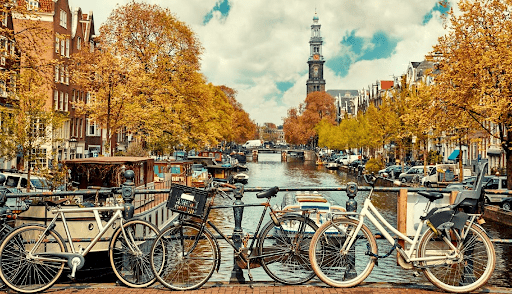
Updated On: November 07, 2023 by Ciaran Connolly
Amsterdam is the capital city of The Netherlands. It is the country’s most populous city and its most visited. Dubbed The Venice of the North for its numerous canals, Amsterdam is a popular destination for students and young travellers because of its rich history, beautiful architecture, and free-spirited atmosphere. It has one of the lowest cost-of-living rates in Europe, is plentiful in cultural diversity, relaxed in its regulation of cannabis, and has a highly desirable healthy work and life balance for its permanent residents.
Proud of its history and culture, Amsterdam has no shortage of museums for locals and tourists to indulge in.
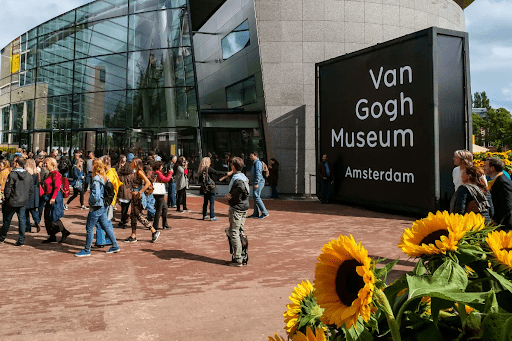
Source: Civitatis
The Van Gogh Museum
Museumplein 6, 1071 DJ Amsterdam, Netherlands
Opening times: Monday – Sunday: 9.00am – 5.00pm
Vincent Van Gogh was a Dutch artist known mostly for his vibrant paintings. His style was predominantly post-impressionist – a French art movement (1886 – 1906) with a focus on abstract and symbolic art – and in his short lifetime he produced over 2000 pieces of art, over 800 of which were oil paintings, before falling victim to suicide at the age of 37. Although unappreciated in his own time, often not seeing any profit or praise for his work which fed his mental illness (particularly his depression) and reduced him to a life of poverty, Van Gogh has become one of the Western world’s most famous and influential artists. He is widely considered to be one of the foundations of Modern Art.
Located in Museum Square, within walking distance of Stedelijk Museum, the Rijkmuseum, and the Concertgebouw, the Van Gogh Museum was opened in June 1973 and is home to the largest collection of Van Gogh artworks in the world. After Van Gogh’s works were left to his brother Theo, and then upon his death to his wife Joanna, they were maintained by Joanna who believed in spreading awareness of her brother-in-law’s works. In 1925, the collection was handed down to Joanna’s son and Van Gogh’s nephew Vincent Willem Van Gogh, who loaned it to the Stredijk for a brief period before, in 1962, handing it over to a state-initiated Van Gogh Foundation.
The Van Gogh Museum, designed by Gerrit Rietveld and Kisho Kurokawa, is an immensely popular attraction in Amsterdam, bringing in over two million visitors in 2017 alone. It is in the top thirty most visited museums in the world. The museum not only features most of Van Gogh’s work, but also selected works from his contemporaries such as Claude Monet and Pierre Bonnard, and contemporary artists inspired by Van Gogh’s life and work, including Steven Aalders, John Chamberlain, and Jason Brooks.
Alongside the exhibitions, the Van Gogh Museum also provides a free-access reading room in their library, home to ‘excess of 35,000 books and articles and it also subscribes to more than forty magazines and auction catalogues. The library acquires around 1,000 new publications every year’, and the Van Gogh Museum Academy, a ‘platform for scholarly research and activities on Van Gogh and the art of his time’.
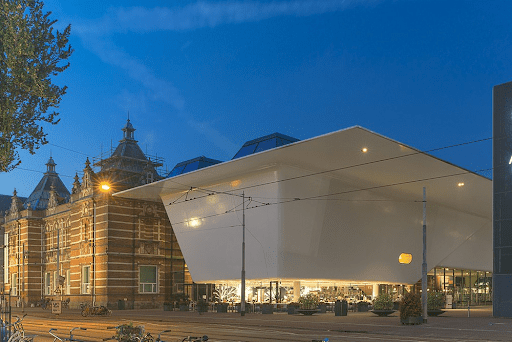
Source: Amsterdam Sights
Stedelijk Museum Amsterdam
Museumplein 10, 1071 DJ Amsterdam, Netherlands
Opening times: Monday – Sunday: 10.00am – 6.00pm
The Stedelijk Museum is the heart of Amsterdam’s modern and contemporary art scene; its collection is largely made up of 20th and 21st century art. Their goal is ‘to enrich people’s lives with art’. Their ‘collection, exhibitions, publications, research and educational programs offer unique and compelling insights into today’s world and highlight topics that impact our societies and individual lives. Our interactions between audiences and art are driven by dialogues with artists. We explore complex topics of yesterday, today and tomorrow – as defined by artists and signalled by ourselves – in an adventurous program. This vision is guided by a fresh, energetic approach to displaying, caring for and renewing our world-famous collection’. Located in Museum Square, the Stedelijk is home to a wide variety of contemporary artists’ work, including Andy Worhol, Jackson Pollock, Marlene Dumas, and Gilbert & George.
The unusual building was designed in the late 1890s by Dutch Neo-Renaissance architect Adriaan Willem Weissman, with the goal of bringing a sense of modernity to Amsterdam. Initially, the Stedelijk ‘maintained a diverse collection, which included works of contemporary Dutch and French masters but also period rooms and even the banners of citizens’ militias. Beginning around 1920, however, the collection was culled and the focus concentrated more rigorously on modern and contemporary art, including pioneering collections and exhibitions of design and photography’.
The Stedelijk holds almost 90,000 pieces of artwork and represents most of the major art movements since the beginning of the 20th century, most notably post-impressionism, graphic design, bauhaus, and modern pop art.
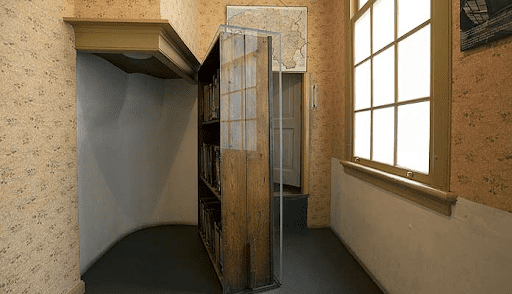
Source: Amsterdam Tips
Anne Frank House
Westermarkt 20, 1016 GV Amsterdam, Netherlands
Opening times: Monday – Sunday: 9.30am – 4.30pm
Immortalised through her teenage diary, Anne Frank was a young German-Dutch Jewish girl who documented her experience hiding during the German Occupation of The Netherlands during World War II. Anne’s life tragically ended when her family was discovered; she and her sister Margot perished in Bergen-Belsen concentration camp. The house Anne and her family hid in was preserved and opened to the public as a museum in 1960 after outcry ensued when it was announced that the house would be demolished to make way for a factory. The people of Amsterdam felt that the house should be saved partly for the sake of Otto Frank, Anne’s father and the family’s only survivor, but also so people would never forget the horrors of the War.
Anne Frank House attracted so many visitors that it had to be temporarily closed twice so renovations could be made to accommodate such an enormous number of tourists. Anne Frank House has been mostly preserved to what it was like when Anne and her family lived there, ensuring authenticity. The museum features photographs, quotations and stories, film clips, and several items Anne would have used have been kept, such as the bookcase and personal photographs.
‘After the Anne Frank House had been restored, they asked me if I wanted to have the rooms refurnished. But I said, ‘No. They took everything out during the war, and I want to keep it that way.’’ Otto Frank in het Vrije Volk, 24 mei – 1962
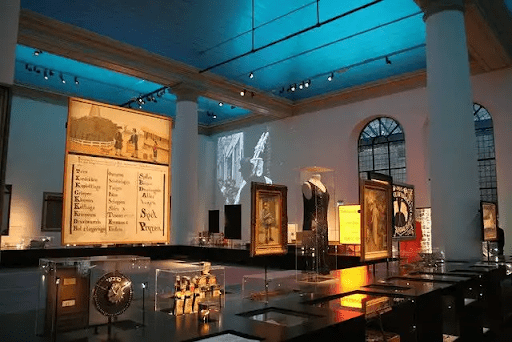
Source: Holland Tickets
Jewish Historical Museum
Nieuwe Amstelstraat 1, 1011 PL Amsterdam, Netherlands
Opening times: Monday – Sunday: 11.00am – 5.00pm
Amsterdam has a rich Jewish history, culture, and legacy which is available to explore in its Jewish Historical Museum in the Jewish Cultural Quarter of the city. It is the only museum in the country dedicated to Jewish history and it predates the Second World War; it was opened to the public in 1932 but was forced to temporarily close during the Nazi occupation.
Unfortunately, much of their collection was lost but since reopening in 1955 in a new location, occupying four former synagogues, the Jewish Historical Museum has since curated over 11,000 objects including ceremonial items, artwork, and objects of historical significance. Its ground floor focuses on culture and customs, and there are two temporary exhibitions on constantly; only 5% of their collection is exhibited at any one time to preserve their state.
The Jewish Historical Museum also features a unique inner museum for children. Its most popular attraction is The Hollander House, a living exhibition designed to enable children to ask questions about modern Jewish culture and traditions: ‘each family member, Mom, Dad, and their three children, shows in his or her own way what it means to them to be Jewish. In the Hollanders’ home, visitors can experience for themselves what is important in the Jewish tradition. For instance, what food do the Hollanders eat, and what don’t they eat? Who is asking so many questions, and why? And why is it sometimes more important to make a lot of noise than to be quiet?’
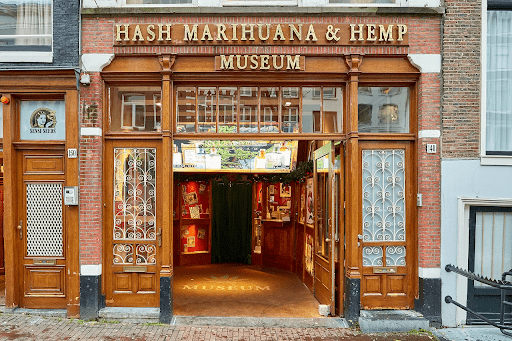
Source: TripAdvisor
Hash Marihuana & Hemp Museum
Oudezijds Achterburgwal 148, 1012 DV Amsterdam, Netherlands
Opening times: Monday – Sunday: 11.00am – 6.00pm
No trip to Amsterdam would be complete without a visit to the Hash Marihuana & Hemp Museum. Established in 1985, it is the oldest museum dedicated to cannabis. Its founder, Ben Dronkers, Dronkers explains that, “the aim of the museum was [and is] to inform people about the significance of hash and marijuana, not only in the coffee shops of Amsterdam, but as a global, cultural and natural phenomenon.”
The museum explores the plant’s rich history and culture, including its role in religions around the world, its role in medicine, and its industrial and agricultural applications. Their exhibitions also provide information on cannabis as a source of healthy food, how it can be used oil, fibre, and plastic, and its role in inspiring art, philosophy, and music.
The Hash Marihuana & Hemp Museum also have a Hemp Gallery which displays art inspired by and about cannabis, including Cannabis in Cartoons and a series of paintings depicting Howard Marks, AKA Mr. Nice, Europe’s most successful cannabis smuggler, by artists such as Goldie and Nick Reynolds.
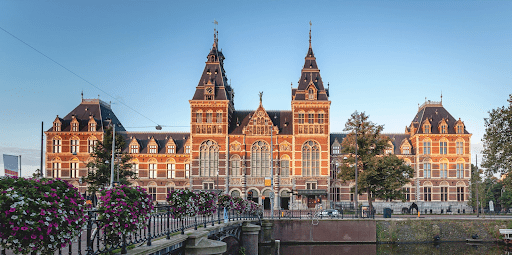
Source: Arcadis
Rijksmuseum
Museumstraat 1, 1071 XX Amsterdam, Netherlands
Opening times: Monday – Sunday: 9.00am – 5.00pm
Located in Museum Square, the Rijksmuseum is a Dutch National Museum – meaning a museum maintained by the state – which is dedicated to history and art in Amsterdam. It is one of Amsterdam’s oldest museums (it was founded in 1798), as well as its largest and most popular; it had over 2.4 million visitors in 2014. It was first located in Amsterdam’s Royal Palace before moving to the Trippenhuis, a neoclassical canal mansion, home to the Royal Netherlands Academy of Arts and Sciences since 1887, in the centre of the city. Its current home was opened by Queen Beatrix in 2013 after a €375 million ten-year renovation.
Ranging from 1200 – 2000AD, the Rijksmuseum has curated 1 million objects, 8,000 of which are on display at any one time. It collects items relating to the history of The Netherlands and is particularly fond of art; it owns over 2,000 pieces of art from the Dutch Golden Age (1581 – 1672), including an extensive Rembrandt collection, and has recently installed a small collection of Asian artworks into their Asian pavilion. The Rijksmuseum also has the stern of HMS Royal Charles, which was captured in the Raid on the Medway, on display alongside the Hartog Plate, the oldest-known artifact of European exploration in Australia still in existence.
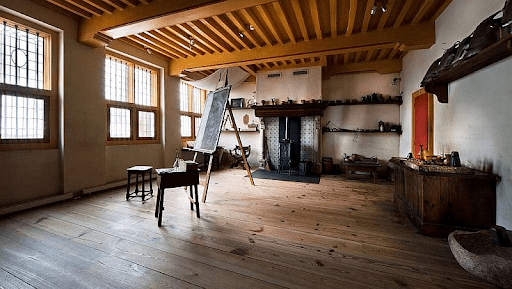
Source: Amsterdam.info
Rembrandt House Museum
Jodenbreestraat 4, 1011 NK Amsterdam, Netherlands
Opening times: Monday – Sunday 10.00am – 6.00pm
Rembrandt Harmenszoon van Rijn was a Dutch artist during the Dutch Golden Age. His work as a draughtsman, painter and printmaker has made him a key figure in the history of art, and arguably the most important Dutch painter of all time. His dark style stood in contrast to the popular Baroque art of the time (characterised by exceptional detail, deep colours, a sense of movement), and unlike his contemporaries who tended to focus on one subject, Rembrandt dabbled in portraits, self-portraits, landscapes, and allegorical, historical, and genre scenes.
Located behind the Red Light District, the Rembrandt House Museum is the restored building Rembrandt called home from 1639 – 1659 until he went bankrupt, forcing him to sell the house and auction off his belongings. The auction list enabled contemporary historians and art dealers to reconstruct most of Rembrandt’s possessions, including busts and a 17th-century bed that was of the style Rembrandt’ would have been. An authentic reconstruction of Rembrandt’s home, the museum’s most popular display is his etchings, which attract over 200,000 visitors per year.
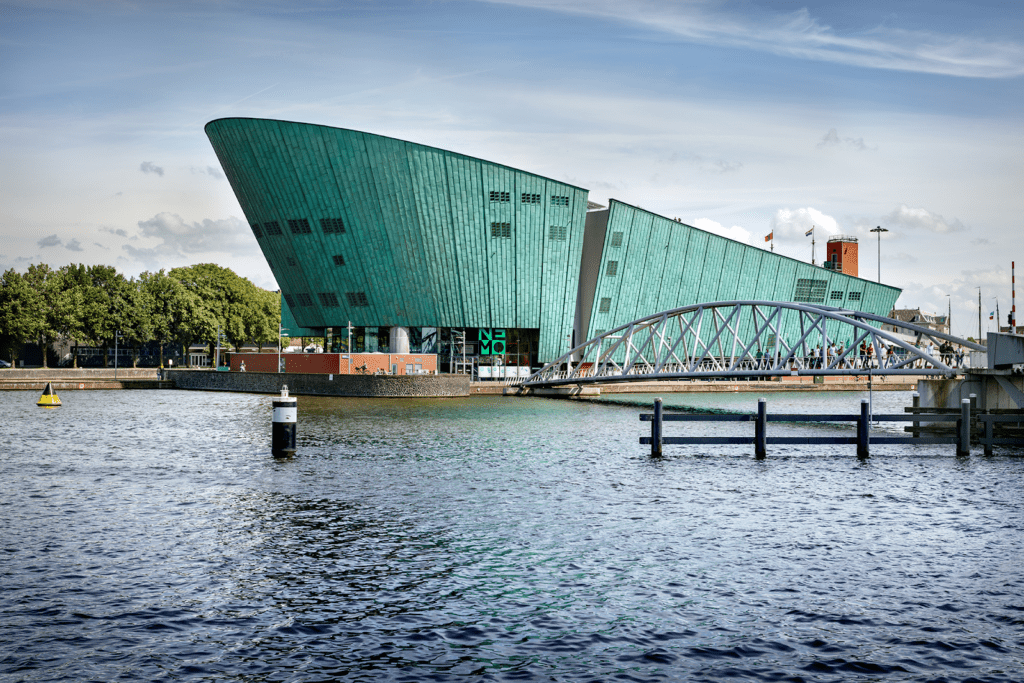
Source: NEMO Science Museum
NEMO Science Museum
Oosterdok 2, 1011 VX Amsterdam, Netherlands
Opening times: Monday – Sunday: 10.00am – 5.00pm
Located in the Oosterdokseiland neighbourhood in the Amsterdam-Centrum borough, between the Oosterdokseiland and the Kattenburg, the NEMO Science Museum is an interactive science centre with five floors of exhibitions. It is The Netherlands’ largest science centre and it attracts over 670,000 visitors per year. It was originally opened by artist Herman Heijenbrock in 1923 as the Museum van den Arbeid (Museum of Labor). It went through several name changes – Nederlands Instituut voor Nijverheid en Techniek (Dutch Institute for Labor and Technology) in 1957, newMetropolis in 1997 and Science Center Nemo in 2000 – before settling on its current name in 2016.
‘Science and technology enable us to better understand the world and ourselves’, their website informs visitors, ‘to develop as human beings, and to prepare the world for the future. NEMO inspires curiosity in both young and old about the power, the importance and the special nature of science and technology’.
NEMO have over 19,000 scientific artifacts which they use to demonstrate how ‘energy has shaped and influenced our world’. They have four core collections – Lighting, Electrical Engineering, Energy Generation and Storage, and Technology at Home – and have exhibits such as The Machine, which allows visitors to become logistical experts, and World of Shapes, a guide to the mathematics of everyday life. A unique feature is their interactive open-air exhibition Energetica, located on the roof of the centre; interactive sculptures enable visitors to learn about the sun, wind, and sustainable energy.
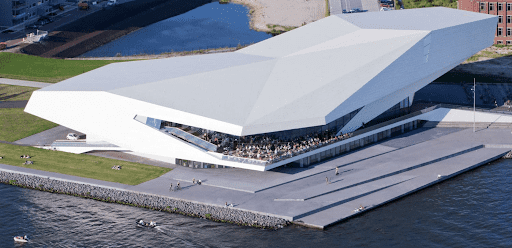
Source: Dutch Review
Eye Film Museum
IJpromenade 1, 1031 KT Amsterdam, Netherlands
Opening times: Monday – Thursday: 10.00am – 10.00pm, Friday – Saturday: 10.00am – 11.00pm, and Sunday: 10.00am – 10.00pm
Often referred to as ‘the cinematic memory of the Netherlands’, the Eye Film Museum is Amsterdam’s unique film archive. With a collection of 37,000 film titles, 60,000 posters, 700,000 photographs and 20,000 books, the Eye Film Museum preserves and presents Dutch and foreign films shown in The Netherlands. Alongside exhibiting older collections, the Eye Film Museum also encourages engagement in modern debates about cinema and cinema history. It is a place for both the amateur and the expert.
Before it was the Eye Film Museum, it was Dutch Historical Film Archive, founded in 1946. It was moved to a new home on the bank of Amsterdam’s waterfront – in a building designed by Delugan Meissl Associated Architects, a firm which specializes in buildings that seem to be in motion – in conjunction with the merging of The Netherlands Institute for
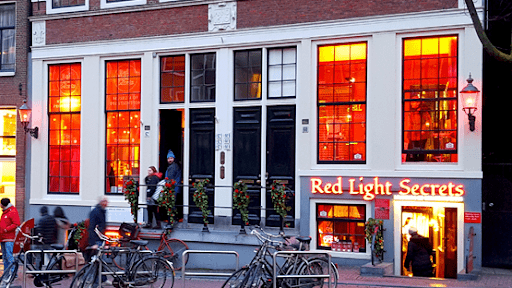
Red Light Secrets – Museum of Prostitution
Source: Red Light District Amsterdam Tours
Red Light Secrets – Museum of Prostitution
Oudezijds Achterburgwal 60h, 1012 DP Amsterdam, Netherlands
Opening times: Monday – Sunday 11.00am – Midnight
One of Amsterdam’s most famous features is its Red Light district. Here, visitors can indulge in sex shops, peep shows, brothels, and strip clubs. Its Museum of Prostitution, the first of its kind, offers a unique glimpse into the world’s oldest profession and the lives of those who choose to embark upon it. The building is a restored 17th-century former brothel and its exhibitions answer some the oldest questions relating to the sex industry: ‘Who chooses to do this work? And why? How much money do they make? What types of people visit a window prostitute? And what happens when the curtains close?’
Their website encourages participation, allowing visitors to access a ‘room where people can sit on a chair in front of two screens that project people passing by, really giving you the feeling how the prostitutes feel. And for those that want to take a picture of a prostitute behind a window, the museum offers a couple of simulated windows that encourages you to take your pictures there’.
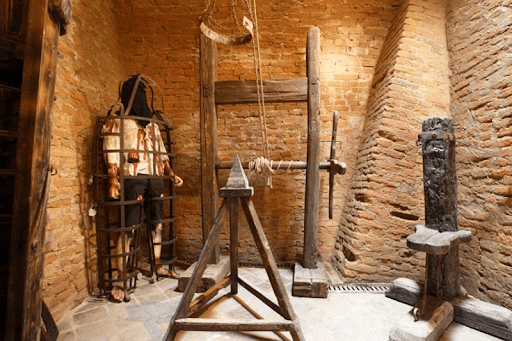
Source: Homecrux
Torture Museum
Singel 449, 1012 WP Amsterdam, Netherlands
Opening times: Monday – Sunday: 10.00am – 11.00pm
Overlooking the Singel Canal, The Torture Museum is a small museum that is often cited as one of the world’s most unusual. Established in 1988, it ‘provides a vivid image of this painful past’ through their extensive range of historical torture instruments, including skullcrackers, racks, swords, saws, and the inquisition chair.
The museum is laid out like a maze, with a series of claustrophobic dark rooms that each house a selected number of torture instruments. Each instrument is accompanied by a book or article which contextualises the instrument by outlining its design, its use, and its timeline.
While part of their goal is to show visitors items of historical significance, the Torture Museum makes it clear that these instruments belong in the past and have no place in a civilised world. They stand direct opposition to the Death Penalty and subscribe to the ‘fundamental principles of human rights, especially the UN Convention against Torture’. They maintain the museum is for educational purposes only.
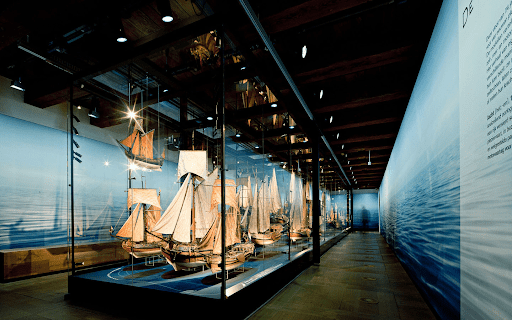
Source: atelier-brueckner
The National Maritime Museum
Kattenburgerplein 1, 1018 KK Amsterdam, Netherlands
Opening times: Monday – Sunday: 10.00am – 5.00pm
Amsterdam’s National Maritime Museum (Nederlands Scheepvaartmuseum) is a museum dedicated to the curation and display of objects relating to ships and travel via water. Their motto is ‘water connects worlds’, and they work towards this by focusing on three core areas: firstly, through pioneering and investigating, ‘our knowledge centre’s team of specialists and researchers is constantly working to further expand and enrich our pioneering collection and library. Together we develop exciting exhibitions and make our research accessible to everyone’; secondly, by being involved and urgent, ‘the world faces many changes and challenges. We can use past, present, and future maritime developments to encourage debate on current issues’; and thirdly, being entrepreneurial and connective, ‘we are entrepreneurial by nature; we stimulate talent and take up a prominent position in society. Our open culture, with a focus on inclusivity and visitor participation, forms the foundation for productive collaborations’.
The museum has many maritime items on display, including reconstructions of ships, ship decoration and information regarding their craftsmen, uniforms, cutlery, and maps. Permanent exhibits include ‘Naviogational Instruments’, ‘Maps and Marvels’, and ‘Republic at Sea’. Most of the exhibits are interactive and encourage visitors to get involved and experience what maritime life was like for their Dutch ancestors.

Source: CW’s Food and Travel
Amsterdam Cheese Museum
Prinsengracht 112, 1015 EA Amsterdam, Netherlands
Opening times: Monday – Sunday: 9.00am – 7.00pm
One of Amsterdam’s more unusual attractions is their Amsterdam Cheese Museum. A short walk from Anne Frank House, this small museum not only offers a unique cheese tasting experience, but it also takes visitors through the history of cheesemaking in The Netherlands. Here, visitors can ‘learn more about Dutch cheese, see the most expensive cheese slicer of the world and have fun dressing up like a traditional Dutch cheese farmer’.
Amsterdam Cheese Museum is run by young entrepreneurs who have a detailed understanding of the history and process of Dutch cheesemaking, and have a selection of unusual and less well-known cheese for tourists and locals alike to try.






